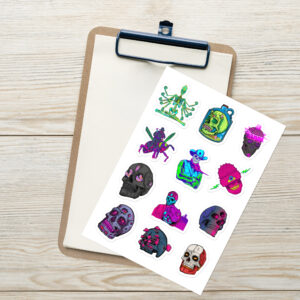Bones of Expression: The Enduring Allure of Skulls in Art

The human skull, a symbol that has captivated artists and societies for millennia. This emblem of mortality, revered and feared, has found a prominent place in the realm of Skull Art, a genre that continues to fascinate and inspire both viewers and Skull Artists alike. From the catacombs of ancient civilizations to the hallowed halls of modern galleries, the skull symbol has journeyed through history, each era adding layers to its enduring allure.
Ancient Beginnings: Skulls in Early Civilizations
The story of Skull Art begins in the depths of human history. Ancient civilizations, understanding the importance of the skull as the seat of the soul and intellect, incorporated this symbol into their artistic expressions in various forms. In Mesopotamia, skulls were often used in burial rites and depicted in carvings and sculptures as a tribute to the gods and a reminder of life’s transience. Meanwhile, in Mesoamerican cultures, such as the Maya and Aztecs, skulls were central in art and architecture, symbolizing death and rebirth.

The Middle Ages: A Symbol of Mortality
As we venture into the Middle Ages, Skull Art takes a more direct, unflinching look at mortality. The infamous ‘memento mori’ – Latin for ‘remember you must die’ – became a prevailing theme. Skulls in this era served as a stark reminder of the inevitability of death, urging onlookers to lead a virtuous life. This was a time when the Black Death swept through Europe, and the skull, often depicted alongside other symbols of death, became a poignant and ubiquitous motif in paintings, sculptures, and even jewelry.

Renaissance Reflections: Vanity and Vanity
With the arrival of the Renaissance, Skull Art evolved yet again. Artists like Hans Holbein the Younger and Albrecht Dürer infused their works with skulls, not just as morbid symbols but as reflections on life’s vanities. In Holbein’s ‘The Ambassadors’, for instance, a cleverly distorted skull serves as a subtle yet striking memento mori, reminding viewers of the futility of earthly pleasures and achievements.
The Influence of Religion and Folklore
Religion and folklore played significant roles in shaping the narrative of Skull Art. In Christianity, skulls often appeared in depictions of saints and martyrs, symbolizing the eternal soul and the promise of resurrection. Meanwhile, in various folk traditions, skulls were seen as protective totems or vessels of ancient wisdom, often portrayed in a more positive and sometimes even whimsical light.
The evolution of Skull Art took a dramatic turn as the world transitioned into the modern era. This period marked a departure from the predominantly religious and moral interpretations of skulls in art, giving way to more diverse and complex representations. In this segment, we explore how Skull Artists in the modern and contemporary era have embraced and redefined Skull Art, infusing it with new meanings and perspectives.

Breaking Traditional Boundaries: The Modernist Approach
In the modernist era, artists began to challenge traditional notions of art and symbolism. The skull, once a solemn memento mori, started to take on different meanings. Pablo Picasso, for instance, used skull imagery to explore themes of war, mortality, and existential angst in a world recovering from the ravages of World War I. His use of fragmented forms and abstract representations marked a significant shift in how Skull Art was perceived and interpreted.
Pop Art and the Skull: A Symbol of Consumerism
The advent of Pop Art in the mid-20th century brought another dimension to Skull Art. Artists like Andy Warhol transformed the skull from a symbol of death to a commentary on consumerism and the ephemeral nature of fame and materialism. His vibrant, mass-produced skull prints challenged the traditional solemnity associated with skull imagery, infusing it with irony and a critique of modern culture.

Contemporary Skull Artists: Diversity and Innovation
In the contemporary art scene, Skull Art continues to thrive, with numerous artists dedicating their careers to exploring this motif. Renowned Skull Artists like Damien Hirst and Georgia O’Keeffe have pushed the boundaries of this genre. Hirst, with his diamond-encrusted skull ‘For the Love of God’, combines luxury with mortality, creating a striking commentary on wealth, death, and the art market. O’Keeffe, on the other hand, used skulls in her paintings to represent the beauty and resilience of the natural world, particularly in her iconic Southwestern landscapes.
Digital Age and Skull Art
The digital age has also left its mark on Skull Art. With the advent of digital tools and mediums, contemporary Skull Artists have the freedom to experiment with innovative techniques and presentations. This has led to a proliferation of skull imagery in various digital art forms, from graphic design to 3D modeling, making it more accessible and diverse than ever.

The modern and contemporary eras have witnessed a remarkable transformation in the world of Skull Art. Moving beyond its origins as a symbol of death and morality, it has evolved into a versatile and dynamic form of expression. Skull Artists of these eras have not only embraced the skull’s rich history but have also imbued it with contemporary relevance, ensuring its continued allure and significance in the art world.
SHARE IT:
LATEST PRODUCTS
-
Apparel
Brujeria Indian Psychedelic Short-Sleeve Skull T-Shirt
Rated 0 out of 5$29.99 – $32.00 Select options This product has multiple variants. The options may be chosen on the product page -
Apparel
Strong Sci-Fi Shaman Short-Sleeve Skull T-Shirt
Rated 0 out of 5$29.99 Select options This product has multiple variants. The options may be chosen on the product page



